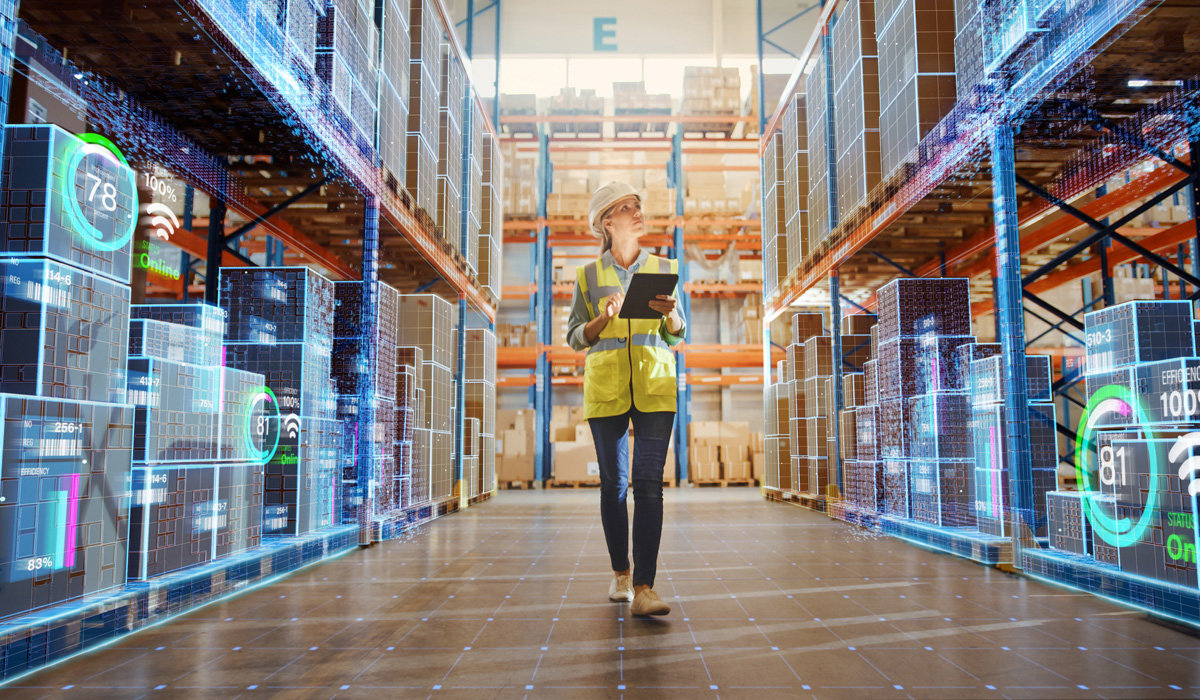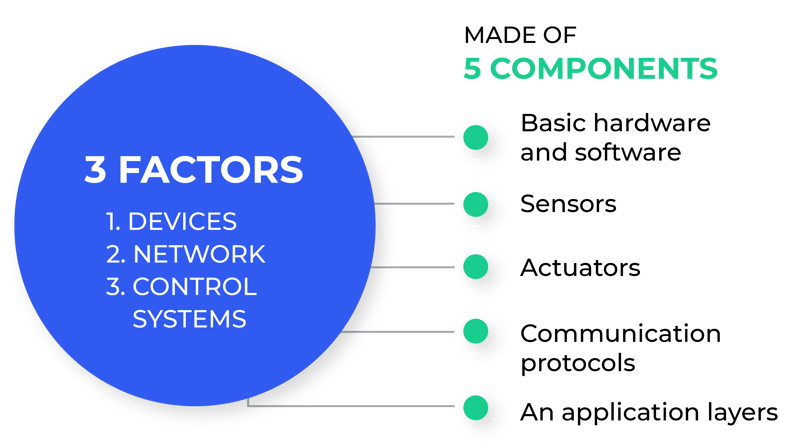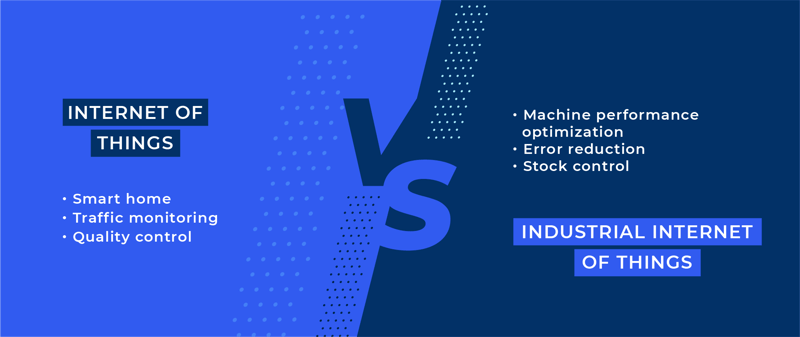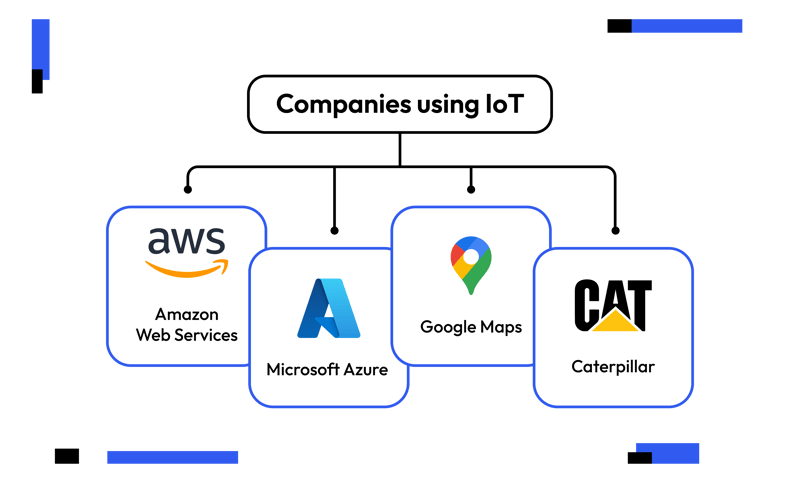
The Internet of Things (IoT) describes the network of physical objects integrated with sensors, software, and other technologies with interrelated computing devices.
These devices range from everyday household items such as refrigerators to trash cans with the ability to be always connected to the Internet to receive and transfer data through your Internet connection.
Discover how the Internet of Things (IoT) works, its evolution, applications, and benefits.
Table of contents
- How does IoT work?
- The evolution of IoT
- IoT applications in organizations
- IoT Benefits
- Companies using IoT
- IoT and autonomous artificial intelligence
How does IoT work?

The Internet of things works through software or applications where the objects connected to the Internet are managed and controlled remotely and in real-time to carry out actions or exchange information.
For the Internet of things to work correctly and have the possibility of exchanging, facilitating, and creating actions, these three factors must be combined:
Devices: refrigerators, coffee machines, clocks, televisions, and more. These objects must be equipped with technologies capable of providing communication, such as chips, Internet connections, sensors, and antennas, among others.
Network: it is the means of communication. They are technologies such as Wi-Fi, Bluetooth, and 3G, 4G, and 5G mobile data.
Control systems: it is necessary for all the data captured from the devices through the network to be processed and sent to a system that controls every aspect and creates connections between the devices.
In addition to these three factors, various components are needed to create an optimal communication protocol for each device.
Any device within the Internet of things must have these 5 components for its operation:
1. Basic hardware and software: it allows the connection of each object to the Internet called SoC (system on chip) microcontrollers.
2. Sensors: SoCs are responsible for collecting information from object sensors to send to the Internet. Various sensors include motion, temperature, pressure, and more.
3. Actuators: based on the information received by an SoC, they are responsible for acting on an actuator, such as accelerating a machine, turning on a light, allowing current to pass through a circuit, and more.
4. Communications protocol: it is specific for the information to be sent and received from the Internet; multiple protocols depend on the solution time you want to perform.
5. Application layer: it provides services between the devices and the end-user.
More and more, we can witness a remarkable evolution in our devices and the processes within companies thanks to this tool.
Currently, IoT devices are mainly divided into three layers where each one has its operation and control to execute actions in each process:
1. Physical layer: These are the devices, sensors, and controllers that make up the IoT environment; it refers to an intelligent device that can be connected to a network to be part of the Internet of things.
2. Computer layer: it specializes in storing and processing the data generated by these devices. It defines networks and communication protocols used for connectivity.
3. Application layer: it is the set of integrated services that are provided to the IoT cloud to obtain essential and valuable information from the data that was previously generated.
Connectivity is the primary tool in IoT systems since it allows communication between devices and machines, allowing the constant sending, receiving, and analyzing of data.
This tool makes it easier for people and technologies such as Artificial Intelligence or Machine Learning to study and establish machine behavior.
The evolution of IoT
In 1999, Kevin Ashton, co-founder of the Auto-ID Center at MIT, first mentioned the term Internet of Things in a presentation he gave to P&G to define a network that connects not only people but also objects around us. But the idea of connected devices has been around since the 1970s, thanks to the Internet and computing.
The first device that used this technology was in the early 1980s, a Coca-Cola machine at Carnegie Mellon University, where programmers could check the machine's status and determine if drinks were at optimal temperatures.
Currently, these systems can do much more for us; they can send information in seconds to have it available all the time and from any device or account with access to these files.
IoT evolved machine-to-machine (M2M2) communication. This means they connect through a network without human intervention and specialize in connecting devices to the cloud, managing and collecting data.
Two decades later, IoT has become an indispensable technology for many. Thanks to the development of communication technologies and the speed of Internet connections, it is expected that by 2025 the number of mobile subscriptions to 5G networks will exceed 2,500 million devices connected through the IoT.
The use of IoT has grown thanks to connecting these platforms with critical systems such as traffic, energy, transportation, security, and more essential services.
IoT applications in organizations

In work organizations, IoT connects different devices to collect data and send it to specific platforms. We convert it into information to make the right decisions, protect systems, automate processes, monitor data in real-time and analyze it.
These are 3 Internet of Things (IoT) applications for organizations and home use.
1. Smart Home.
Various devices are currently part of our home, from controlling the lighting, the music we want to play, locks, video surveillance cameras, and more objects we can control with our voice or a simple application.
2. Traffic monitoring.
We can install applications on our cell phones to contribute and learn about current traffic conditions and where we are going or want to go. It shows us road conditions, estimated arrival time, alternative routes, and more.
3. Quality control.
For organizations, the quality of their products is essential at each stage of production. The company's efficiency can be analyzed, faults detected, and the appropriate solutions applied to eliminate them and create greater customer satisfaction.
Currently, there is the Industrial Internet of Things (IIoT) that has come to impact industries to manage processes in assembly lines, logistics, or large-scale distribution. It is a set of sensors, instruments, and autonomous devices connected through the Internet.
These are 3 applications of the Industrial Internet of things (IIoT):
1. Optimization of machine performance. Millions of companies create their products from machines, so they must work effectively and without any problem or delay. Thanks to sensors and data processing, workers can optimize their time use.
2. Error reduction. Although most companies use machines for their processes, collaborators are essential in millions of tasks. In contrast, IIoT is a crucial tool to analyze the process and optimize human tasks to avoid process delays or errors within production.
3. Stock control. Thanks to this technology, the status of each product or order can be known, where the collaborators and areas of the company can obtain constant information about the quality of the supply chain and possible incidents in each process to provide a quick solution, minimizing the costs of production.
In short, the Internet of Things (IoT) focuses on services for consumers or small businesses. The Industrial Internet of Things (IIoT) focuses on increasing the safety and efficiency of large production centers or large companies.
IoT benefits

Implementing IoT in organizations is critical in maintaining their competitive advantages and evolution.
These are the 4 main benefits that organizations obtain when implementing the Internet of Things.
Cost reduction. When implementing technologies such as IoT or artificial intelligence requires an initial investment. Still, in the process, organizations can notice the cost reduction in their operations to automate and monitor them where failure is predicted, which will prevent an increase in product prices.
We improved productivity and efficiency. A great benefit of IoT that companies have noticed is that it improves the productivity of employees and machines. These connected systems can reorganize resources to optimize production while saving time; in addition, the tasks of each area can be divided, increasing productivity, motivation, and job satisfaction.
Decision making. IoT helps organizations make the right decisions and see failures based on data and information that it stores, manages, and analyzes from the market, customers, and even processes within the company. It allows us to plan effective strategies, reinforce the brand's image, and research the market's reaction before launching new products or services to know which segment to target.
Business opportunities...... Through data analysis and information, companies can invent or reinvent products or services depending on users' preferences, allowing them to know their market in-depth and anticipate events or needs where they gain customer loyalty.
Companies using IoT

As we have seen, the use of IoT has multiple benefits for several kinds of environments, from the personal use of IoT within a household to its implementation in large-scale operations such as businesses or factories. The following are some companies that are either developers of IoT software and hardware or that have implemented IoT in their activities in some way or another.
Microsoft (Azure: Cloud computing, cost reduction, improved productivity)
As one of the computer and technology pioneers of the past century, Microsoft is also deeply intertwined with IoT. One of its most famous platforms, Azure, provides a large number of services such as networking, analytics, data management, and cloud storage. These can be integrated with Microsoft 365, which includes the Office Suit and other useful programs.
As most of the information can be stored in the cloud and accessed through several devices (such as smartphones, tablets, laptops, or desktop computers), Microsoft’s platform has proven to be essential to many businesses, schools, and homes, as it reduces costs of transfer of information and can increase the productivity of the enterprises. While Microsoft is the largest user of the Azure Platform, a lot of companies (like AT&T, eBay, or Dell) use the platform one way or another in their daily activities.
Amazon Web Services
Home automation is one of the most known applications of IoT nowadays. Amazon has been known to offer several products for this purpose like the smart assistant Alexa, smart bulbs, smart cameras, and other appliances that connect to a single network which can be controlled with easiness with a single voice command or from a smartphone. This is possible in part thanks to the platform Amazon Web Services (AWS)which is a provider of cloud computing services owned by Jeffrey Bezos’s company. Some companies that utilize AWS in services for computing, storage, analytics, and Machine Learning are Twitter, Netflix, Epic Games, and even Pfizer.
Google Maps (Traffic monitoring)
The proper working of Google Maps depends a lot on IoT. This popular application has several uses other than applications: it also provides satellite images (Google Earth), 360° POV images of certain addresses (Street View), business listings, and real-time information about the traffic in certain routes or the concurrency of people at a certain place and at a certain hour.
To extract all this information, the application connects to their servers and to any other user with Google Maps on their smartphone and uses that data to update the states of roads and the vacancies in certain spots like cafeterias or parking lots. It also uses satellite imagery and a data bank of millions of photos of the streets to provide images of Google Earth and Street View.
For business listings, the collaboration of the users is pivotal as they can register a business, as well as a contact number, an address, the hours in which it is open, and even reviews of the place.
Caterpillar (Quality control and safety of the workers)
As we have seen, IoT has other applications within industries. Caterpillar, one of the biggest companies in construction equipment, has recently started to implement IoT applications both to guarantee the quality of their products but also to ensure the safety of their workers. For example, several workers in the mines of the company have helmets with embedded cameras connected to a network that helps to assess if the working conditions are safe and optimal. Inside their factories, a network of cameras, sensors, speakers, and software, among other things, helps create a safe environment while at the same time, it monitors the quality of products and the productivity of the assembly lines.
IoT and autonomous artificial intelligence
The Internet of things (IoT) has come to change our daily lives, achieving synchronization between human beings and machines and allowing devices and objects to be connected through technologies such as Artificial Intelligence, Autonomous Artificial Intelligence, and Machine Learning. Thanks to these tools, devices within the IoT can be configured with other objects to perform actions on their own with a previous indication.
IoT and Artificial Intelligence are cutting-edge technologies that have helped hundreds of organizations and individuals to use electronic devices more simply and interactively and elevate what was done before with just one of these technologies.
Today, we have these types of tools in our homes: voice recognition, facial recognition, object scanning, drones, and more products that we can control with an app or device.
It is a tool that is increasingly becoming part of our lives, and with other technologies.
If you are interested in learning more about the technologies that are part of the IoT, we invite you to read our article on Autonomous Artificial Intelligence and Machine Learning.
And if you want to know in detail how IoT integrates with larger and more complex technologies, we invite you to read our guide on intelligent systems here.